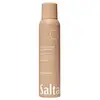What's inside
What's inside
 Key Ingredients
Key Ingredients

No key ingredients
 Benefits
Benefits

 Concerns
Concerns

 Ingredients Side-by-side
Ingredients Side-by-side

Hydrofluorocarbon 152a
Butane
Alcohol Denat.
AntimicrobialOryza Sativa Starch
AbsorbentBambusa Vulgaris Shoot Extract
AntioxidantNelumbo Nucifera Flower Extract
Skin ConditioningButyrospermum Parkii Butter
Skin ConditioningDisteardimonium Hectorite
StabilisingDiisopropyl Adipate
EmollientParfum
MaskingDistarch Phosphate
AbsorbentMaltodextrin
AbsorbentLinalool
PerfumingBenzyl Salicylate
PerfumingHexyl Cinnamal
PerfumingHydrofluorocarbon 152a
Butane
Oryza Sativa Starch
AbsorbentSd Alcohol 40-B
AstringentDisiloxane
Skin ConditioningArgania Spinosa Kernel Oil
EmollientPvp
Emulsion StabilisingWater
Skin ConditioningParfum
MaskingMagnesium Stearate
Cosmetic ColorantDiisopropyl Adipate
EmollientCetrimonium Chloride
AntimicrobialMethoxycinnamidopropyl Hydroxysultaine
UV AbsorberCI 60725
Cosmetic ColorantCI 17200
Cosmetic Colorant
 Reviews
Reviews

Ingredients Explained
These ingredients are found in both products.
Ingredients higher up in an ingredient list are typically present in a larger amount.
Butane is a gas derived from petroleum and natural gas. It is used as an aerosol propellant.
Diisopropyl Adipate comes from isopropyl alcohol and Adipic Acid.
It is a solvent and emollient. As a solvent, it is used to help other ingredients dissolve into the solution. It is also often used to soften hard ingredients.
Emollients help hydrate the skin by creating a thin barrier. This thin barrier prevents moisture from escaping.
Learn more about Diisopropyl AdipateWe don't have a description for Hydrofluorocarbon 152a yet.
Oryza Sativa Starch is an absorbent and used to mattify the skin. It is a natural carbohydrate and the main component of rice. A more common name for this ingredient is 'rice starch'.
Rice starch is created by steeping broken grains in a caustic soda.
Rice extract has many skin benefits. Read more about rice extract here.
Learn more about Oryza Sativa StarchParfum is a catch-all term for an ingredient or more that is used to give a scent to products.
Also called "fragrance", this ingredient can be a blend of hundreds of chemicals or plant oils. This means every product with "fragrance" or "parfum" in the ingredients list is a different mixture.
For instance, Habanolide is a proprietary trade name for a specific aroma chemical. When used as a fragrance ingredient in cosmetics, most aroma chemicals fall under the broad labeling category of “FRAGRANCE” or “PARFUM” according to EU and US regulations.
The term 'parfum' or 'fragrance' is not regulated in many countries. In many cases, it is up to the brand to define this term.
For instance, many brands choose to label themselves as "fragrance-free" because they are not using synthetic fragrances. However, their products may still contain ingredients such as essential oils that are considered a fragrance by INCI standards.
One example is Calendula flower extract. Calendula is an essential oil that still imparts a scent or 'fragrance'.
Depending on the blend, the ingredients in the mixture can cause allergies and sensitivities on the skin. Some ingredients that are known EU allergens include linalool and citronellol.
Parfum can also be used to mask or cover an unpleasant scent.
The bottom line is: not all fragrances/parfum/ingredients are created equally. If you are worried about fragrances, we recommend taking a closer look at an ingredient. And of course, we always recommend speaking with a professional.
Learn more about Parfum